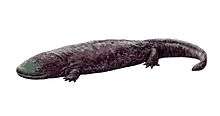Andrias scheuchzeri
| Andrias scheuchzeri Temporal range: Oligocene to Pliocene, 34–5 Ma | |
|---|---|
 | |
| Holotype (in middle) at Teylers Museum, Scheuchzer's Homo diluvii testis | |
| Fossil | |
| Scientific classification | |
| Kingdom: | Animalia |
| Phylum: | Chordata |
| Class: | Amphibia |
| Order: | Caudata |
| Family: | Cryptobranchidae |
| Genus: | Andrias |
| Species: | †A. scheuchzeri |
| Binomial name | |
| Andrias scheuchzeri (Holl, 1831) | |
| Synonyms | |
| |
Andrias scheuchzeri is an extinct species of giant salamander, which only is known from fossils. It lived from the Oligocene to the Pliocene.[1] It and the extant A. davidianus cannot be mutually diagnosed, and the latter, only described in 1871, is therefore sometimes considered a synonym of the former.[2]
History

In his book Lithographia Helvetica from 1726, Johann Jakob Scheuchzer described a Miocene fossil found in Oeningen as Homo diluvii testis (Latin: Man, a witness of the Deluge), believing it to be the remains of a human that drowned in the biblical Deluge. The fossil was about 1 m (3 ft) long, lacked its tail and hind legs, and could thus be interpreted as showing some resemblance to the remains of a violently trampled human child.

In 1758, the first to doubt his theory was Johannes Gessner, who thought it was a giant catfish (Siluris). In 1777 Petrus Camper thought it was a lizard (Lacerta), and at that time there was no differentiation between reptiles and amphibians by the scientific community. In 1802 Martin van Marum bought this fossil along with a fossilized swordfish for 14 Louis d'or for the Teylers Museum, where it can still be seen in the original showcase. In 1811, the fossil was examined by Georges Cuvier, who recognized it definitively as not being human. After hacking away gently at the fossil, he uncovered the foremost limbs and the specimen was recognized as a giant salamander. The difference in color of the stone shows what Scheuchzer saw and what Cuvier later could see.
The specimen was renamed Salamandra scheuchzeri by Friedrich Holl in 1831. The genus Andrias was only coined six years later by Johann Jakob von Tschudi. In doing so, both the genus, Andrias (which means image of man), and the specific name, scheuchzeri, ended up honouring Scheuchzer and his beliefs. The Teylers Museum has several other specimens in their collection in addition to this one.
In fiction
The fictional descendants of Andrias scheuchzeri are the primary antagonists in Karel Čapek's 1936 science fiction novel War with the Newts.
Sources
- ↑ http://www.wahre-staerke.com/~madelaine/EGU2010_Andrias.pdf
- ↑ Amphibian Species of the World 5.1. Genus Andrias. Accessed 2008-04-10.
- Aquagenesis: The Origin and Evolution of Life in the Sea by Richard Ellis
- Fossil Salamanders of North America (Life of the Past) by J. Alan Holman
- Cradle of Life: The Discovery of Earth's Earliest Fossils by J. William Schopf
- The Swedish popular scientific magazine Illustrerad vetenskap 2/2008
- Amphibians: The World of Frogs, Toads, Salamanders and Newts by Robert Hofrichter